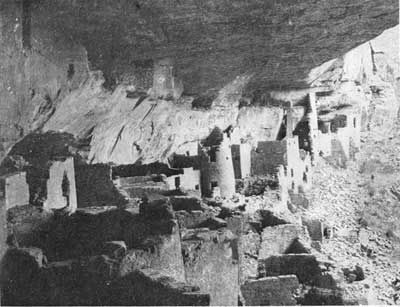In the following pages the walls and other remains of
buildings and the objects found in the rooms have been treated from
their cultural point of view. Considering ethnology, or culture
history, as the comparative study of mental productions of groups of men
in different epochs, and cultural archeology as a study of those objects
belonging to a time antedating recorded history, there has been sought
in Cliff Palace one type of prehistoric American culture, or rather a
type of the mental production of a group of men in an environment where,
so far as external influences are concerned, caves, mesas, and cliffs
are predominant and aridity is a dominant climatic factor. Primarily
archeology is a study of the expression of human intelligence, and it
must be continually borne in mind that Cliff Palace was once the home of
men and women whose minds responded to their surroundings. It is hoped
that this monograph will be a contribution to a study of the influence
of environment on the material condition of a group of prehistoric
people. The condition of culture here brought to light is in part a
result of experiences transmitted from one generation to another, but
while this heritage of culture is due to environment, intensified by
each transmission, there are likewise in it survivals of the culture due
to antecedent environments, which have also been preserved by heredity,
but has diminished in proportion, pari passu, as the epoch in which
they originated is farther and farther removed in time from the
environment that created them. These survivals occur mostly in myths and
religious cult objects, and are the last to be abandoned when man
changes his environment.
It is believed that one advantage of a series of
monographic descriptions of these ruins is found in the fact that the
characteristics of individual ruins being known, more accurate
generalizations concerning the entire culture will later be made
possible by comparative studies. There is an individuality in Cliff
Palace, not only in its architecture but also in a still greater measure
in the symbolism of the pottery decoration. These features vary more or
less in different ruins, notwithstanding their former inhabitants were
of similar culture. These variations are lost in a general description
of that culture.
The reader is asked to bear in mind that when the
repair of Cliff Palace was undertaken the vandalism wrought by those who
had dug into it had destroyed much data and greatly reduced the
possibility of generalizations on the character of its culture. The ruin
had been almost completely rifled of its contents, the specimens
removed, and its walls left in a very dilapidated condition. Much of the
excavation carried on under the writer's supervision yielded meager
scientific results so far as the discovery of specimens was concerned,
throughout the summer earth was being dug over that had already been
examined and cult objects removed. Had it been possible to have begun work
on Cliff Palace just after the ruin was deserted by the aboriginal
inhabitants, or, as that was impossible, at least anticipated only by
the destruction wrought by the elements, these explorations might have
illumined many difficult problems which must forever remain
unsolved.
The present monograph is the second in a series
dealing with the antiquities of the Mesa Verde National Park and opening
with the account of the excavation and repair of Spruce-tree
House.a An exhaustive account of all known antiquities from
Cliff Palace is not intended, and no reference is made even to many
objects from that ruin now in museums. Discussion of details is not so
much aimed at as brevity in the statement of results and a contribution
to our knowledge of a typical form of Southwestern culture. Believing
that modern Pueblo culture is the direct descendant of that of
cliff-dwellers, the writer has not hesitated to make use of ethnology, when
possible, in an interpretation of the archeological material.
aBulletin 41 of the Bureau of American
Ethnology.
Although the name Cliff Palace is not altogether an
appropriate one for this ruin, it is now too firmly fixed in the
literature of cliff-dwellings to be changed. The term "palace" implies
a higher social development than that which existed in this village,
which undoubtedly had a house chief similar to the village chief
(kimongwi) of the Hopi, who occupied that position on account of
being the oldest luau of the oldest clan; but this ruin is not the
remains of a "palace" of such a chief.
The population of Cliff Palace was composed of many
clans, more or less distinct, and independent, which were rapidly being
amalgamated by marriage; so we may regard the population as progressing
toward a homogeneous community. Cliff Palace was practically a pueblo
built in a cave; its population grew from both without and within: new
clans from time to time joined those existing, while new births
continually augmented the number of inhabitants.
There was no water at Cliff Palaceb when work
began, but a good supply was developed in the canyon below the ruin,
where there is every reason to believe the former inhabitants had their
well. In a neighboring canyon, separated from that in which Cliff Palace
is situated by a promontory at the north, there is also a meager seepage
of water which was developed incidentally into a considerable supply. In
the cliff above this water is a large cave in which was discovered the
walls of a kiva of the second type, but the falling of a large block of
rock upon it—which occurred subsequent to the construction of this
kiva—led to its abandonment. This cave is extensive enough for a
cliff-house as large as Cliff Palace; but for this accident it might
have developed into a formidable rival of the latter.
bAll potable water for camp had to be brought
from Spruce-tree House, about 2 miles away.


Plate 3. THE SOUTHERN END, AFTER AND BEFORE
REPAIRING (photographed by R. G. Fuller)
|



